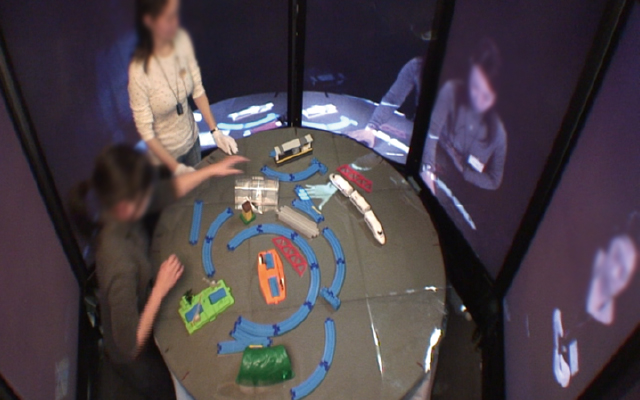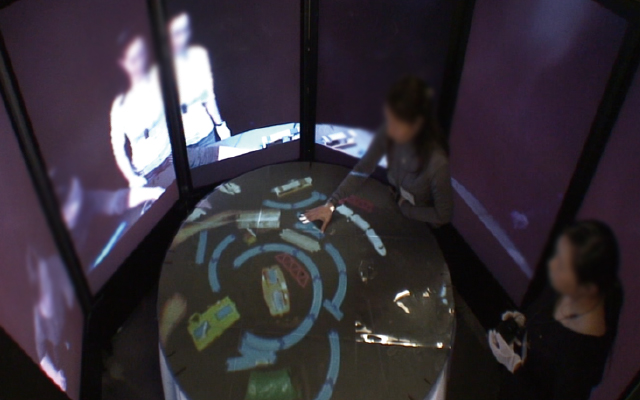情報技術を用いて人と寄り添う社会を作る
- HOME
- RESEARCH
Overview
あらゆる人が多様な価値観を持ちつつ支え合うことができるインクルーシブな未来社会の実現を目指します。そのために、行動科学や社会心理学の理論や方法論に基づき、人と人のつながりを深化させるコミュニケーション基盤技術の研究を進めます。情報技術そのものの高度化や多機能化を追求するより、人間観察や調査を通して現場のニーズやインタラクションの本質を解明し、それらの理解に基づいた情報技術をデザインします。
We envision an inclusive society in which all people can support each other with diverse values. To this end we use theories and methodologies from social science and psychology to research communication technologies that deepen connections between people. Rather than pursuing the advancement and multifunctionality of information technology itself, we elucidate the essential needs of users and uncover the nature of interaction through human observation, and then design information technology based on this understanding.
Inclusive Design
障がいの有無、性別や国籍などの違いに関わりなく、マイノリティの人々がマジョリティの人々と同等に豊かな生活を行えるように情報技術をデザインすることをインクルーシブ・デザインと呼びます。本研究では、グローバル・プロジェクトにおける非母語話者の参画支援やうつ病患者の社会復帰支援、LGBTの人々の出会い・交流支援など、それぞれのマイノリティが持つ固有のニーズを認知・感情・社会の側面から把握し、それらに応える情報技術を開発し、社会実装による検証を行います。また、各マイノリティの包摂に必要な共通デザインを見出すことによって、インクルーシブ・デザインの基盤モデルの構築を目指します。
Inclusive design refers to the design of information technology to enable minorities to live as rich a life as the majority, regardless of their disabilities, gender, nationality, or other differences. The aim of this research is to understand the unique needs of each minority group from cognitive, emotional, and social perspectives, develop technologies to meet these needs, and then install/deploy the technologies in the real-world. Finally, by identifying commonalities among different dimensions of minority experiences, we aim to develop a model for inclusive design.
Example Projects
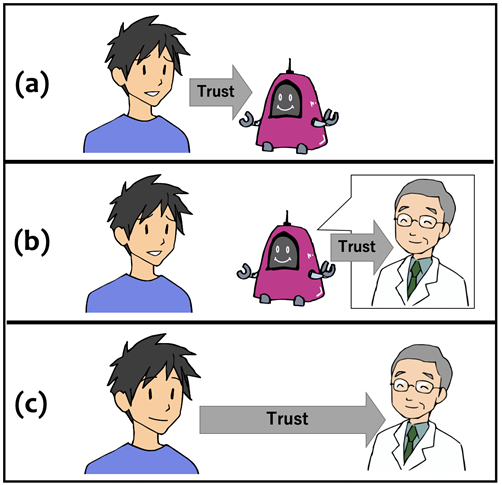
Title: Designing a Chatbot as a Mediator for Promoting Deep Self-Disclosure to a Real Mental Health Professional
Authors: Yi-Chieh Lee, Naomi Yamashita, Yun Huang
Abstract: Chatbots are becoming increasingly popular. One promising application for chatbots is to elicit people’ selfdisclosure of their personal experiences, thoughts and feelings. As receiving one’s deep self-disclosure is critical for mental health professionals to understand people’s mental status, chatbots show great potential in the mental health domain. However, there is a lack of research addressing if and how people self-disclose sensitive topics to a real mental health professional (MHP) through a chatbot. In this work, we designed, implemented and evaluated a chatbot that offered three chatting styles; we also conducted a study with 47 participants who were randomly assigned into three groups where each group experienced the chatbot’s self-disclosure at varying levels respectively. After using the chatbot for a few weeks, participants were introduced to a MHP and were asked if they would like to share their self-disclosed content with the MHP. If they chose to share, the participants had the options of changing (adding, deleting, and editing) the content they self-disclosed to the chatbot. Comparing participants’ self-disclosure data the week before and the week after sharing with the MHP, our results showed that, within each group, the depth of participants’ self-disclosure to the chatbot remained after sharing with the MHP; participants exhibited deeper self-disclosure to the MHP through a more self-disclosing chatbot; further, through conversation log analysis, we found that some participants made different edits on their self-disclosed content before sharing it with the MHP. Participants’ interview and survey feedback suggested an interaction between participants’ trust in the chatbot and their trust in the MHP, which further explained participants’ self-disclosure behavior.

Title: Why Did They Do That? Exploring Attribution Mismatches Between Native and Non-Native Speakers Using Videoconferencing
Authors: Helen Ai He, Naomi Yamashita, Ari Hautasaari, Xun Cao, Elaine M. Huang
Abstract: The meaning we attribute to another’s actions significantly impact our subsequent behaviors and interactions towards that person. Distributed teams often combine native speakers (NS) and non-native speakers (NNS) and are particularly prone to making attribution errors. Language difficulties place NNS under a higher cognitive load, potentially leading NS to make inaccurate attributions of NNS. We conducted an exploratory laboratory study to investigate the attributions NS and NNS form about each other in multiparty videoconferencing. Our findings revealed significant mismatches in NS’ attributions of NNS behavior, but no significant mismatch in NNS’ attributions of NS behavior. Due to cognitive overload stemming from language challenges, NNS were only able to engage in “compromised” impression management during the task. Yet, NS were relatively unaware of how profoundly language difficulties impacted NNS’ behaviors. Our findings identify opportunities for technology support for NS-NNS interactions, particularly with regards to impression construction and impression management.

Title:”So Close, yet so Far”: Exploring Sexual-Minority Women’s Relationship Building via Online Dating in China
Authors: Yichao Cui, Naomi Yamashita, Mingjie Liu, Yi-Chieh Lee
Abstract: Sexual-minority women (SMWs) in China are often subject to strong stigmatization and tend to have limited opportunities to connect with other SMWs in offline contexts. Although dating apps help them connect and seek social support, little is known about SMWs’ practices of self-disclosure and connection-building through those apps. To address this gap, we interviewed 43 SMW dating-app users in China. We found that these SMWs developed distinctive self-disclosure strategies, such as posting non-facial photos and implicitly disclosing their whereabouts by blending location information into photos that only those in the know could understand, to avoid interference from aggressive acquaintances and other risks of unintentional disclosure of their SMW identities. Moreover, they used dating apps not only to recognize other SMWs offline and build relationships with them, but to exchange emotional support in the process of SMW identity development. Our findings have design implications for supporting SMWs and improving their online dating experiences.

Title: Effects of Machine Translation on Collaborative Work
Authors: Naomi Yamashita, Toru Ishida
Even though multilingual communities that use machine translation to overcome language barriers are increasing, we still lack a complete understanding of how machine translation affects communication. In this study, eight pairs from three different language communities?China, Korea, and Japan?worked on referential tasks in their shared second language (English) and in their native languages using a machine translation embedded chat system. Drawing upon prior research, we predicted differences in conversational efficiency and content, and in the shortening of referring expressions over trials. Quantitative results combined with interview data show that lexical entrainment was disrupted in machine translation-mediated communication because echoing is disrupted by asymmetries in machine translations. In addition, the process of shortening referring expressions is also disrupted because the translations do not translate the same terms consistently throughout the conversation. To support natural referring behavior in machine translation-mediated communication, we need to resolve asymmetries and inconsistencies caused by machine translations.
Mental Wellbeing
情報技術の普及により、誰とでも簡単につながることができるようになった一方で、人間関係の希薄化、分断化、孤立化などの問題が生じ、精神的な健康に悪影響を及ぼすことがあります。私たちは、社会科学や心理学の理論に基づき、それらの問題を緩和し、精神衛生全般を向上させるためのコミュニケーション技術の研究を行っています。
特にメンタルヘルスケアに関する研究では、家庭内介護(医療行為ではなく、平穏な日常生活を送ること)を改善することにより、患者の症状悪化を予防し早期回復を助けるICTツールを開発することを目指しています。2017年までの研究成果をもとに家庭内介護支援アプリ「みまもメイト」を開発し、NPO法人COMHBOにて会員限定で一般公開しました。
While the spread of information technology has made it easy to connect with anyone, it has also created problems of diluted, fragmented, and isolated human relationships, which can negatively impact mental wellbeing. Based on social science and psychology theories, we research communication technologies to alleviate those problems and improve overall mental health.
Example Projects
Title: Impacts of the Strength and Conformity of Social Norms on Well-Being: A Mixed-Method Study Among Hybrid Workers in Japan
Authors: Wataru Akahori, Naomi Yamashita, Jack Jamieson, Momoko Nakatani, Ryo Hashimoto, Masahiro Watanabe
Abstract: Previous studies have suggested that organizational social norms can positively affect employee well-being. However, such social norms have not been well developed during the post-COVID-19 transition to hybrid work, which combines office and remote work, and it is unclear how employees’ perceptions of social norms for hybrid work affect their well-being. In this study, we investigated the impact of social norms for hybrid work on the well-being of hybrid workers living in Japan through a mixed-method approach consisting of an online survey (n = 212) and semi-structured interviews (n = 20). The results indicate that hybrid workers who feel subject to strong social norms have lower well-being. Conversely, those who are more willing to conform to social norms have higher well-being. Given our findings, we discuss implications for the design of systems to help hybrid workers conform to organizational social norms and to improve their well-being.
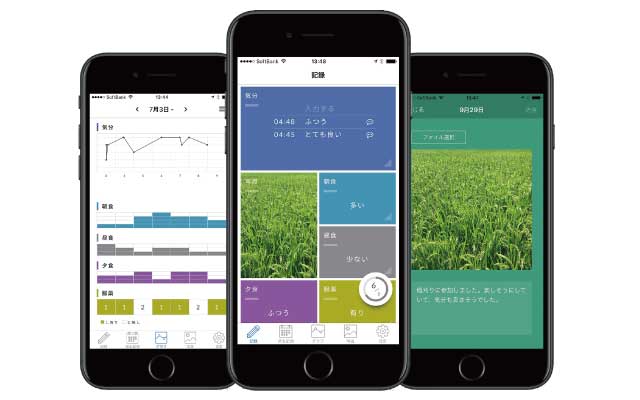
Title: How Information Sharing about Care Recipients by Family Caregivers Impacts Family Communication
Authors: Naomi Yamashita, Hideaki Kuzuoka, Takashi Kudo, Keiji Hirata, Eiji Aramaki,Kazuki Hattori
Abstract: Previous research has shown that tracking technologies have the potential to help family caregivers optimize their coping strategies and improve their relationships with care recipients. In this paper, we explore how sharing the tracked data (i.e., caregiving journals and patient’s conditions) with other family caregivers affects home care and family communication. Although previous works suggested that family caregivers may benefit from reading the records of others, sharing patients’ private information might fuel negative feelings of surveillance and violation of trust for care recipients. To address this research question, we added a sharing feature to the previously developed tracking tool and deployed it for six weeks in the homes of 15 family caregivers who were caring for a depressed family member. Our findings show how the sharing feature attracted the attention of care recipients and helped the family caregivers discuss sensitive issues with care recipients.
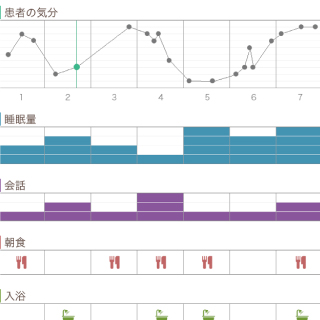
Title: Changing Moods: How Manual Tracking by Family Caregivers Improves Caring and Family Communication
Authors: Naomi Yamashita1, Hideaki Kuzuoka,Keiji Hirata,Takashi Kudo,Eiji Aramaki,Kazuki Hattori
Abstract: Previous research on healthcare technologies has shown how health tracking promotes desired behavior changes and effective health management. However, little is known about how the family caregivers’ use of tracking technologies impacts the patient-caregiver relationship in the home. In this paper, we explore how health-tracking technologies could be designed to support family caregivers cope better with a depressed family member. Based on an interview study, we designed a simple tracking tool called Family Mood and Care Tracker (FMCT) and deployed it for six weeks in the homes of 14 family caregivers who were caring for a depressed family member. FMCT is a tracking tool designed specifically for family caregivers to record their caregiving activities and patient’s conditions. Our findings demonstrate how caregivers used it to better understand the illness and cope with depressed family members. We also show how our tool improves family communication, despite the initial concerns about patient-caregiver conflicts.

Title: Understanding the Conflicting Demands of Family Caregivers Caring for Depressed Family Members
Authors: Naomi Yamashita, Hideaki Kuzuoka, Keiji Hirata, Takashi Kudo
Abstract: Depression is one of the most common disabilities in developed countries. Despite its often devastating impact on families, scant research has focused on how to facilitate the well-being of family caregivers. The aim of this paper is to uncover the challenges faced by family caregivers and support their well-being with the use of technologies. To understand the emotional and social burden of caregivers and how they handle their stress, we conducted in-depth interviews with 15 individuals who have cared for a depressed family member. Our findings reveal the multifaceted dilemma of caring for a depressed family member as well as the various strategies engaged in by caregivers to improve their own situations. Based on our findings, we suggest design implications for healthcare technologies to improve the wellness of caregivers who are looking after depressed family members.
Co-investigator Projects
私たちは多様な文脈・場・環境に合ったコミュニケーション支援技術の試作と評価を繰り返すことにより、
互いの気遣いを生むコミュニケーションをデザインするための基礎理論を構築することを目指します。
●科研費 基盤研究(B)「連鎖的相互行為を支援する超時空間遠隔対話システムの研究開発」(研究代表者:葛岡英明),研究分担者,2017-2019.
メディアを介した遠隔対話において連鎖的な相互行為を支援することを目的とします。
空間を圧縮した撮影・表示形態である全周映像を利用した通信端末と、予期的アウェアネス提示と遅延提示という時間操作を導入した、超時空間遠隔対話環境を提案します。
代表的な研究成果:
- Zhengqing Li, Shio Miyafuji, Toshiki Sato, Hideki Koike, Naomi Yamashita, Hideaki Kuzuoka , “How Display Shapes Affect 360-Degree Panoramic Video Communication,” Proceedings of ACM Conference on Designing Interactive Systems (DIS’18), 845-856.
- Christian Licoppe, Paul Luff, Christian Heath, Hideaki Kuzuoka, Naomi Yamashita, Sylvaine Tuncer, ” Showing Objects: holding and manipulating artefacts in video-mediated collaborative settings,” Proceedings of ACM Conference on Human Factors in Computing Systems (CHI’17), pp. 5295-5306.


●科研費 基盤研究(B)「ソーシャルテレプレゼンスのためのロボットエンハンスドディスプレイ」(研究代表者:中西英之),研究分担者,2014-2017.
日本の街中において実際に実店舗へのロボットの導入を行いながら、世界最高レベルの接客能力を有するロボットの実現を目指します。
代表的な研究成果:
- Hideyuki Nakanishi, Kazuaki Tanaka, Ryoji Kato, Xing Geng, Naomi Yamashita, “Robotic Table and Bench Enhance Mirror Type Social Telepresence,” Proceedings of ACM Conference on Designing Interactive Systems (DIS’17), pp.779-790.
- Kazuaki Tanaka, Naomi Yamashita, Hideyuki Nakanishi, Hiroshi Ishiguro, “Teleoperated or Autonomous?: How to Produce a Robot Operator’s Pseudo Presence in HRI,” Proceedings of ACM Conference on Human Robot Interaction (HRI’16), pp.133-140.
- 田中一晶,山下直美, 中西英之, 石黒浩, “自律・遠隔操作の曖昧化によるロボット操作者との対話感覚の創出,” 情報処理学会論文誌,Vol.57, No.4, pp.1108-1115, 2016.
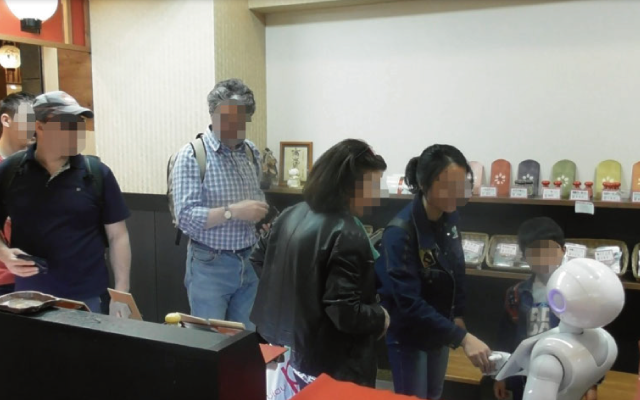
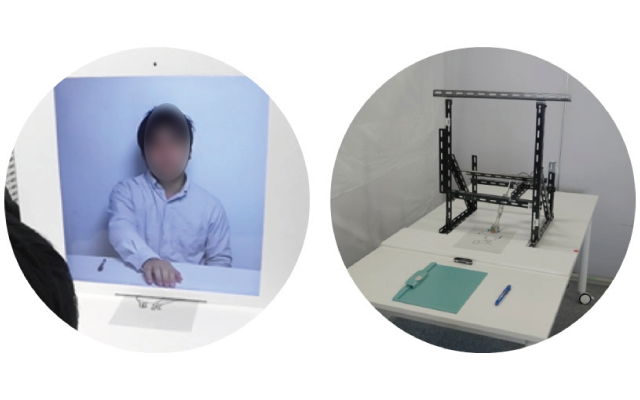
●過去の主要なプロジェクト
「自他の作業空間を区別なく動き回れる実写ベースの遠隔ビデオ協調作業支援の研究」(研究代表者:平田圭二)
遠隔地間で動き回る必要性のある遠隔医療や遠隔教育といった場において、実対面環境に近い円滑で質の高い協調作業を実現することを目指します。私たちは、遠隔地間において視聴覚情報の対称性が保証される(つまり、遠隔ユーザが対等に互いの周辺視聴覚情報を共有できる)システム「t-Room」を開発しました。これを用いて複数の統制実験を行い、対称性が遠隔協調作業に及ぼす影響などについて調査しました。
代表的な研究成果:
- Paul Luff, Naomi Yamashita, Hideaki Kuzuoka, Christian Heath, ” Flexible Ecologies And Incongruent Locations,” Proceedings of ACM Conference on Human Factors in Computing Systems (CHI’15), pp. 877-886. (Honorable Mention Award )
- Naomi Yamashita, Hideaki Kuzuoka, Keiji Hirata, Shigemi Aoyagi, Yoshinari Shirai “Supporting Fluid Tabletop Collaboration across Distances,” Proceedings of ACM Conference on Human Factors in Computing Systems (CHI’11), pp. 2827-2836, 2011.
- Naomi Yamashita, Katsuhiko Kaji, Hideaki Kuzuoka, Keiji Hirata, ” Improving Visibility of Remote Gestures in Distributed Tabletop Collaboration,” Proceedings of ACM Conference on Computer Supported Cooperative Work (CSCW’11), pp. 95-104, 2011.
- 山下直美, 梶克彦, 葛岡英明,平田圭二,青柳滋己, “遠隔ユーザのジェスチャの可視性を向上させる手法の提案と評価,”情報処理学会論文誌, Vol.52, No.1, 2011. (情報処理学会2011年度 論文賞受賞 )
- Naomi Yamashita, Keiji Hirata, Shigemi Aoyagi, Hideaki Kuzuoka, Yasunori Harada “Impact of Seating Positions on Group Video Communication,” Proceedings of ACM Conference on Computer Supported Collaborative Work (CSCW’08), pp. 177-186, 2008.
